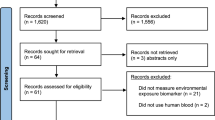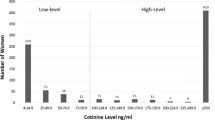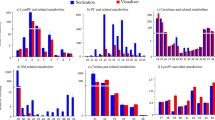Abstract
Tobacco use is the major preventable cause of premature death in the United States. Second-hand smoke (SHS) exposure also contributes to a number of premature deaths as well as other negative health outcomes. An accurate assessment of tobacco smoke exposure is critical to understanding these disease processes. The plasma concentration of cotinine, the primary metabolite of nicotine, is widely accepted as a quantitative measure of tobacco and SHS exposure. However, it is not always feasible to collect plasma. Dried blood spots (DBS), which are collected routinely from newborns and often from young children for lead screening, provide an alternative sampling method. We have developed a quantitative high throughput liquid chromatography tandem mass spectrometry method for the analysis of cotinine in DBS. The limit of quantitation was 0.3 ng/g (∼ 0.2 ng/ml plasma). Cotinine levels in DBS from 83 smokers and 99 non-smokers exposed to SHS were determined. Plasma cotinine concentrations in these subjects ranged from <0.02 to 443 ng/ml. Cotinine was detected in DBS from 157 subjects, and the correlation between cotinine in plasma and DBS was excellent, 0.992 (P<0.001). We also determined the ratio of trans 3′-hydroxycotinine to cotinine, a measure of nicotine metabolism, in DBS from smokers. This ratio in DBS was well correlated with the ratio in plasma, 0.94 (P<0.001). In a small study, we confirmed the feasibility of using extant DBS collected for lead screening to assess SHS exposure in children.
This is a preview of subscription content, access via your institution
Access options
Subscribe to this journal
Receive 6 print issues and online access
$259.00 per year
only $43.17 per issue
Buy this article
- Purchase on Springer Link
- Instant access to full article PDF
Prices may be subject to local taxes which are calculated during checkout




Similar content being viewed by others
References
CDC. Smoking-attributable mortality, years of potential life lost, and productivity losses—United States, 2000–2004. Morb Mortal Wkly Rep 2008; 57: 1226–1228.
United States Department of Health and Human Services How Tobacco Smoke Causes Disease: The Biology and Behavioral Basis for Smoking-Attributable Disease: A Report of the Surgeon General. U.S. Department of Health and Human Services. Washington, D.C, USA,. 2010.
United States Department of Health and Human Services Children and Secondhand Smoke Exposure. Excerpts from The Health Consequences of Involuntary Exposure to Tobacco Smoke. A Report of the Surgeon General. U.S. Department of Health and Human Services. Washington, D.C, USA,. 2007.
Benowitz NL, Hukkanen J, Jacob P . Nicotine chemistry, metabolism, kinetics and biomarkers. Handbook Exp Pharmacol 2009; 192: 29–60.
Benowitz NL . Cotinine as a biomarker of environmental tobacco smoke exposure. Epidemiol Rev 1996; 18: 188–204.
Hukkanen J, Jacob P, Benowitz NL . Metabolism and disposition kinetics of nicotine. Pharmacol Rev 2005; 57: 79–115.
Li W, Tse FL . Dried blood spot sampling in combination with LC-MS/MS for quantitative analysis of small molecules. Biomed Chromatogr 2010; 24: 49–65.
Stove CP, Ingels AS, De Kesel PM, Lambert WE . Dried blood spots in toxicology: from the cradle to the grave? Crit Rev Toxicol 2012; 42: 230–243.
Guthrie R, Susi A . A simple phenylalanine method for detecting phenylketouria in large populations of newborn infants. Pediatrics 1963; 32: 338–343.
Wilcken B, Wiley V . Newborn screening. Pathology 2008; 40: 104–115.
Stanton NV, Maney JM, Jones R . Evaluation of filter paper blood lead methods: results of a pilot proficiency testing program. Clin Chem 1999; 45: 2229–2235.
Spector LG, Hecht SS, Ognjanovic S, Carmella SG, Ross JA . Detection of cotinine in newborn dried blood spots. Cancer Epidemiol Biomarkers Prev 2007; 16: 1902–1905.
Sosnoff CS, Bernert JT . Analysis of cotinine in dried blood spots by LC APCI tandem mass spectrometry. Clin Chim Acta 2008; 388: 228–229.
Murphy SE, Villalta P, Ho SW, von Weymarn LB . Analysis of [3′,3′-d(2)]-nicotine and [3′,3′-d(2)]-cotinine by capillary liquid chromatography-electrospray tandem mass spectrometry. J Chromatogr B Analyt Technol Biomed Life Sci 2007; 857: 1–8.
Bloom J, Hinrichs AL, Wang JC, von Weymarn LB, Bierut LJ, Goate A et al. The contribution of common CYP2A6 alleles to variation in nicotine metabolism aong European Americans. Pharmacogenet Genomics 2011; 21: 403–416.
Jacob P, Yu L, Duan M, Ramos L, Yturralde O, Benowitz NL . Determination of the nicotine metabolites cotinine and trans-3′-hydroxycotinine in biologic fluids of smokers and non-smokers using liquid chromatography-tandem mass spectrometry: biomarkers for tobacco smoke exposure and for phenotyping cytochrome P450 2A6 activity. J Chromatogr B Analyt Technol Biomed Life Sci 2011; 879: 267–276.
Newborn Screening Quality Assurance Program: Filter Paper Comparison Study. http://www.cdc.gov/labstandards/pdf/nsqap/nsqap_FilterPaperStudy51809.pdf2009.
Collection of Fingerstick Whole Blood on Filter Paper for Blood Lead Determination. http://www.medtox.com/Resources/Images/2763.pdf2012.
Clinical and Laboratory Standards Institute (CLSI). Blood collection on filter paper for newborn screening programs; Approved standard fifth edition. CLSI document LA4-A5. Clinical and Laboratory Standards Institute: Wayne, Pennsylvania, USA. 2007.
Mei JV, Alexander JR, Adam BW, Hannon WH . Use of filter paper for the collection and analysis of human whole blood specimens. J Nutr 2001; 131: 1631S–1636S.
American Academy of Pediatrics Committee on Environmental Health. Lead exposure in children: prevention, detection, and management. Pediatrics 2005; 116: 1036–1046.
Advisory Committee on Childhood Lead Poisoning Prevention (ACCLPP). Recommendations for blood lead screening of young children enrolled in medicaid: targeting a group at high risk. MMWR Recomm Rep 2000; 49: 1–13.
Wengrovitz AM, Brown MJ . Recommendations for blood lead screening of Medicaid-eligible children aged 1–5 years: an updated approach to targeting a group at high risk. MMWR Recomm Rep 2009; 58: 1–11.
United States Environmental Protection Agency EPA Report on the Environment: Blood Cotinine Level. http://cfpub.epa.gov/eroe/index.cfm?fuseaction=detail.viewInd&lv=list.listByAlpha&r=223968&subtop=208, 2010.
Spliethoff HM, Tao L, Shaver SM, Aldous KM, Pass KA, Kannan K et al. Use of newborn screening program blood spots for exposure assessment: declining levels of perluorinated compounds in New York State infants. Environ Sci Technol 2008; 42: 5361–5367.
Chaudhuri SN, Butala SJ, Ball RW, Braniff CT . Pilot study for utilization of dried blood spots for screening of lead, mercury and cadmium in newborns. J Expo Sci Environ Epidemiol 2009; 19: 298–316.
Mannino DM, Albalak R, Grosse S, Repace J . Second-hand smoke exposure and blood lead levels in U.S. children. Epidemiology 2003; 14: 719–727.
Apostolou A, Garcia-Esquinas E, Fadrowski JJ, McLain P, Weaver VM, Navas-Acien A . Secondhand tobacco smoke: a source of lead exposure in US children and adolescents. Am J Public Health 2012; 102: 714–722.
Dempsey DA, Meyers MJ, Oh SS, Nguyen EA, Fuentes-Afflick E, Wu AH et al. Determination of tobacco smoke exposure by plasma cotinine levels in infants and children attending urban public hospital clinics. Arch Pediatr Adolesc Med 2012; 166: 851–856.
Dempsey D, Tutka P, Jacob P, Allen F, Schoedel K, Tyndale RF et al. Nicotine metabolite ratio as an index of cytochrome P450 2A6 metabolic activity. Clin Pharmacol Ther 2004; 76: 64–72.
Strasser AA, Benowitz NL, Pinto AG, Tang KZ, Hecht SS, Carmella SG et al. Nicotine metabolite ratio predicts smoking topography and carcinogen biomarker level. Cancer Epidemiol Biomarkers Prev 2011; 20: 234–238.
Joseph AM, Spector LG, Wickham KM, Janis G, Winickoff JP, Lindgren B et al. Biomarker evidence of tobacco smoke exposure in children participating in lead screening. Am J Public Health 2013 (in press).
Acknowledgements
This work was supported by NHLBI 1RC2HL10140. LC-MS/MS analysis was carried out in the Analytical Biochemistry Shared Resource of the Masonic Cancer Center supported, in part, by CA-77598.
Author information
Authors and Affiliations
Corresponding author
Ethics declarations
Competing interests
The authors declare no conflict of interest.
Rights and permissions
About this article
Cite this article
Murphy, S., Wickham, K., Lindgren, B. et al. Cotinine and trans 3′-hydroxycotinine in dried blood spots as biomarkers of tobacco exposure and nicotine metabolism. J Expo Sci Environ Epidemiol 23, 513–518 (2013). https://doi.org/10.1038/jes.2013.7
Received:
Accepted:
Published:
Issue Date:
DOI: https://doi.org/10.1038/jes.2013.7
Keywords
This article is cited by
-
Coordinating smoking cessation treatment with menstrual cycle phase to improve quit outcomes (MC-NRT): study protocol for a randomized controlled trial
Trials (2023)
-
A state-of-the-science review and guide for measuring environmental exposure biomarkers in dried blood spots
Journal of Exposure Science & Environmental Epidemiology (2023)
-
Differences in exposure to toxic and/or carcinogenic volatile organic compounds between Black and White cigarette smokers
Journal of Exposure Science & Environmental Epidemiology (2021)
-
Little to Give, Much to Gain—What Can You Do With a Dried Blood Spot?
Current Environmental Health Reports (2020)
-
Epigenetic signatures of smoking associate with cognitive function, brain structure, and mental and physical health outcomes in the Lothian Birth Cohort 1936
Translational Psychiatry (2019)



